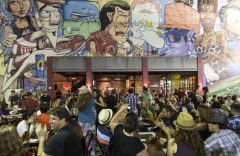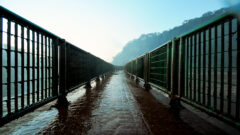Adventure on Costa Rica’s High Seas

Travel journalist Sarah Gilbert embarks upon a cruise with a difference
It was dark when I first caught sight of the Star Flyer. She was anchored out in Puerto Caldera harbour under a star-studded sky, her rig bedecked with hundreds of twinkling lights.
A replica of the four-masted clippers that plied oceans in the 19th century, she was about to embark on a new route along Costa Rica's dramatic Pacific coastline where the diverse ecosystems range from steamy rainforest in the south to misty cloud-forest in the north. And what better way to explore its remote bays and islands than by tall ship?
Our first day at sea gave me the chance to explore. Artfully combining naval tradition with modern technology, the Flyer has 85 air-conditioned cabins decked out with mahogany and brass fittings where, once, sailors slept in hammocks. She has a state-of-the-art engine but is under sail whenever the wind blows.
When I boarded I didn't know my spanker from my mizzen but it was thrilling to watch her sails unfurl and hear the rig come alive with creaks and groans as we left harbour to the strains of Vangelis's Conquest Of Paradise.
Dining was intimate and informal with a tasty feast each night. You could choose where to sit which led to a convivial atmosphere and usually drinks in the open-sided Tropical Bar. Entertainment was homespun fun rather than lavish shows or casinos. There was music every night, quizzes, performances by local artists and talent contests.
For some true clipper-ship participation you had the chance of climbing up to the crow's nest, joining the captain on the bridge or lending a hand hoisting the sails.
During the 10-day voyage guests could also join in the aerobics or aquasize classes in one of the two swimming pools, the perfect tonic to offset the gastronomic delights on offer.
The ship's gentle motion was like being rocked in a cradle. I slept like a baby and awoke one morning to find we'd anchored in Panama's Gulf of Chiriquí in a landscape dotted with dozens of islets. We landed on a spit of sand populated only by coconut palms, and the translucent water was bath-warm as I snorkelled with shoals of tiny iridescent fish flitting around me.
Heading north back to Costa Rica our next port of call was Golfito, a town the United Fruit Company built from scratch in 1938 and then abandoned in 1985. Tourism has overtaken bananas now so we jumped into four-wheel-drive vehicles and bumped up the mountains until almost in the clouds.
Costa Rica is the birthplace of zip-lining and there's no more thrilling way to view the rainforest and its inhabitants. As I tentatively stepped off the platform a toucan flew past to check out the strange bird in its territory. My descent over the treetops was accompanied by the low roar of howler monkeys and a huge rush of adrenaline.
That night we set sail for the Osa Peninsula, one of Costa Rica's wildest and most isolated areas. We anchored in Drake Bay, named after Sir Francis Drake who docked in 1579.
After a 40-minute motorboat ride to a rocky outcrop dripping in emerald vegetation and home to nesting frigate birds, terns, egrets and brown boobies, we glided along narrow mangroves and past a motionless caiman.
Randall, the ship's resident naturalist guide, provided us with entertaining talks on the staggering diversity of Costa Rica's wildlife, the reason the Spanish conquerors christened it the Rich Coast. With a land mass two-thirds the size of Scotland the country nevertheless boasts an estimated six per cent of the world's flora and fauna, with more than 160 national parks.
Manuel Antonio National Park, a 20-minute drive from Quepos port, is one of the most popular. It's small at just over 1,600 acres, but has stunning beaches, lush rainforest, a network of trails and wildlife galore. Our sharp-eyed guide spied a three-toed sloth lazily clambering up a tree and we spotted a posse of white-faced capuchin monkeys scampering from branch to branch.
The Nicoya Peninsula, home to some of Costa Rica's most beautiful beaches, was the final stop on our enthralling trip. As I relaxed on Isla Tortuga's sweep of golden sand, shaded by palms and edged by turquoise water, I looked out at our ship.
She was an impressive sight surrounded by an admiring bevy of small boats and jet skis, her sails billowing in the gentle breeze, bright white against the brilliant blue sky.
Next morning as I boarded the tender to take me back to Puerto Caldera I was told that if you look back at the ship as you leave you're sure to return.
I craned my neck to catch a last glimpse of Star Flyer and didn't turn away until I hit dry land.
By Sarah Gilbert, Travel Journalist.
This voyage is no longer available; follow this link for expedition cruises you may be interested in.
Tailor-made holidays
Flexible, custom-made holidays to Latin America created to match your exact requirements: our tailor-made itineraries are as unique as the clients for whom they are designed.
Design my tripPapagaio
Your edit for Latin American inspiration
Our exciting range of articles on Latin America explore everything from iconic destinations and lesser-known cultural gems to delicious traditional recipes. You’ll also find exclusive travel tips, first-hand client reviews and the chance to get your personal questions answered by our travel experts.
View Extraordinary Inspiration






































